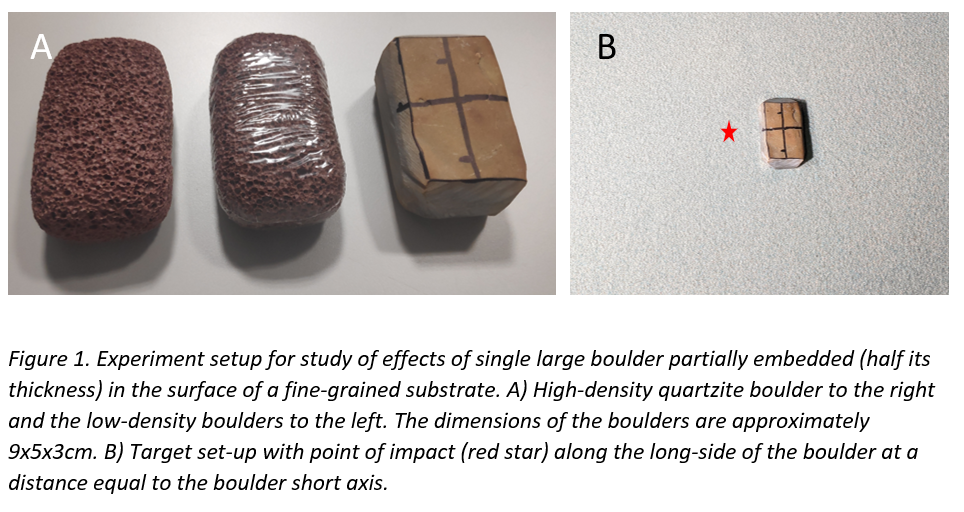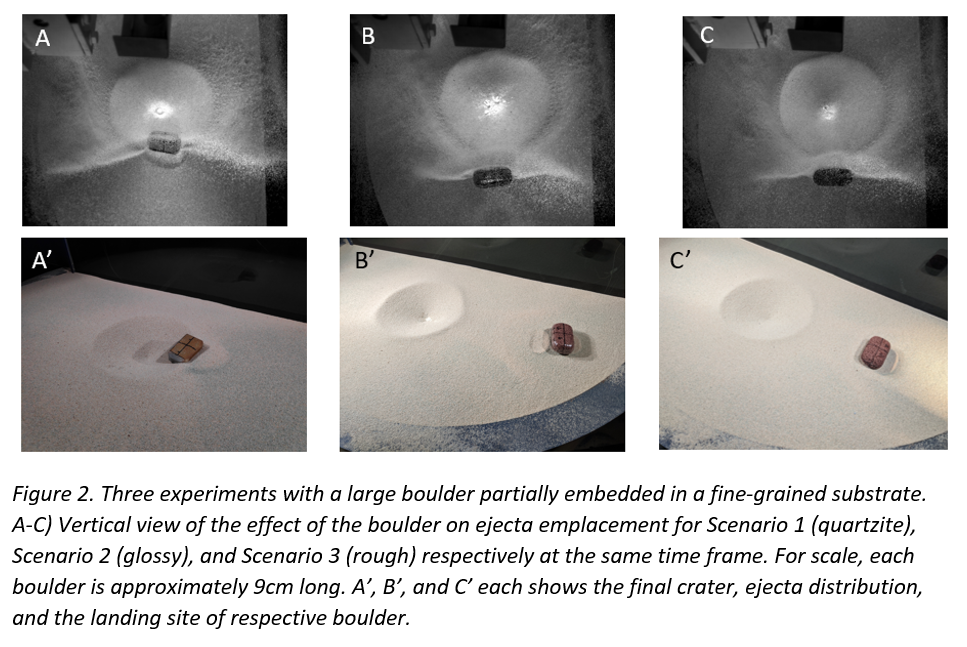Impact Induced Motion of Boulders and Their Effect on Ejecta Emplacement on Rubble-pile Targets
- 1Centro de Astrobiologia (INTA-CSIC), Dept Planetology and Habitability, Torrejon de Ardoz, Spain (ormoj@cab.inta-csic.es)
- 2Space Research and Planetary Sciences, University of Bern, Switzerland
- 3Museum für Naturkunde Berlin, Leibniz Institute for Evolution and Biodiversity Science, Germany
- 4Department of Earth Science Engineering, Imperial College London, UK
- 5Freie Universität Berlin, Germany
Introduction: Asteroids smaller than about 50 km in diameter are the result of the break-up of a larger parent body [1]. They are often considered to be rubble-pile objects, aggregates held together only by self-gravity or small cohesive forces [2, 3], and have highly heterogeneous surfaces. Recently, the artificial impact experiment (SCI) of JAXA’s Hayabusa2 mission on the surface of asteroid Ryugu [4] created a relatively large crater (~14 m diameter) despite the presence of large boulders close to the impact location [5].
Post-impact images of the SCI impact site revealed that the boulders had different motion mechanisms depending on their size and initial position relative to the impact point. 1 m-sized boulders were ejected several metres outside of the crater, a 5 m boulder was moved about 3m, while a large, possibly deeply rooted boulder (“Okamoto”) was not moved [4]. Impact cratering on weak, heterogeneous targets is still poorly studied, both by means of laboratory experiments and numerical simulations. For example, it is not yet known how the boulders affect the crater size or how the boulders motion is affected by their mass, size, shape or initial location.
This is also important in context of NASA’s Double Asteroid Redirection Test (DART) impact on the surface of Dimorphos (the secondary of the 65803 Didymos asteroid system) on the 26th of September 2022. The impact will demonstrate the controlled deflection capabilities of near-Earth asteroids by a kinetic impactor [6]. ESA’s Hera mission [7] will arrive at Dimorphos several years after the DART impact and provide a detailed characterisation of the impact outcome.
Recent impact experiments and numerical studies [8, 9, 10, 11] have shown that the kinetic impact efficiency depends strongly on the target properties and structure. The understanding thereof is imperative for a successful interpretation of the DART impact outcome. Most previous impact experiments and subsequent validation work of numerical models have focused on homogeneous targets [e.g, 12, 13, 14]. However, it is unlikely that Dimorphos is homogeneous at the scale of DART impact.
In our previous work we studied impacts into granular targets with embedded porous, spherical boulders and their effect on cratering process, final crater morphology, boulder emplacement, and ejecta distribution [15, 16]. We showed that crater diameters are only slightly affected by heterogeneities as long as the energy required for crushing is small compared to impact energy. However, less mass is ejected at higher velocities compared to homogeneous targets, which reduces the momentum enhancement.
In this study we present results from recently conducted experiments at the Experimental Projectile Impact Chamber (EPIC) at Centro de Astrobiología CSIC-INTA, Spain, which focused on the motion mechanism of large boulders placed close to the impact site (Fig. 1). We also study the effect of density and surface roughness of boulders located on the target surface on their mobilisation and ejection, as well as on the excavation flow and ejection of fine-grained matrix.
Methods: The EPIC utilises a 20 mm calibre compressed N2 (300 bar) cannon that launches projectiles at velocities up to ≈420 m/s [13]. The experiments, half- or quarter-space, can be recorded with two high-speed cameras. In the three experiments presented here we have kept the impact velocity constant at approximately 400m/s. The projectiles were 20mm massive, spherical delrin balls. All shots were vertical and in half space.
We performed three shots into a loosely packed beach sand in which a single, relatively large rectangular boulder was placed (Fig. 1). Coloured sand on the surface allows studies of ejecta distribution. In the first shot (Scenario 1) the boulder had relatively high bulk density (quartzite, ~ 2.8 g/cm3), in the second shot (Scenario 2) the boulder had relatively low density (highly porous pumice, ~ 0.27 g/cm3) and a glossy surface (the boulder was covered in a plastic film). In the last shot (Scenario 3) the same object was used, but now the glossy plastic film had been removed revealing a rough, high-friction surface (Fig. 1A). In all experiments the point of impact was located as shown in Figure 1B.

Results and discussion: We observe a significant difference in the ejection behaviour between the cases with boulders of different mass. In Scenario 1, the boulder was moved a few cm by the excavation flow and deposited at the crater rim. The ejecta curtain passes around the boulder, creating a “forbidden zone” behind the boulder (Fig. 2A). Similar ejecta behaviour was seen during the SCI impact around the Okamoto boulder [4].
In Scenarios 2 and 3, the boulder was excavated with the ejecta curtain, rotated around its length axis, and landed about one crater diameter away from the crater. The ejecta curtain was again disrupted by the presence of the boulder (Fig. 2 B, C). The final rim-diameter of the crater produced in Scenario 1 was 27cm and in the other two scenarios 29 cm, suggesting that the presence of a dense (i.e., mainly stationary) boulder close to the impact point does not greatly affect the crater size. However, we can clearly see a significant influence of the boulder on the ejecta curtain behaviour. The dense boulder efficiently block the ejecta while the low-density boulders to great extent travel with the ejecta mainly affecting the distal parts of the continuous ejecta layer. The surface roughness had no obvious effect on boulder movement.

Conclusions and future work: Here we continue our study of impacts into heterogeneous targets (The first study was presented at EPSC2021 [15]) and work towards understanding the importance of target heterogeneities in the cratering process and impact momentum transfer. Numerical simulations reproducing these impact experiments are underway and preliminary results from the early cratering process show good agreement with the experiments. These results and further numerical studies are vital for understanding cratering processes on rubble-pile asteroids and will help interpret results from the DART impact and its imaged ejecta plume.
How to cite: Ormö, J., Raducan, S. D., Luther, R., Jutzi, M., Herreros, M. I., Collins, G., Wünnemann, K., and Mauri, V.: Impact Induced Motion of Boulders and Their Effect on Ejecta Emplacement on Rubble-pile Targets , Europlanet Science Congress 2022, Granada, Spain, 18–23 Sep 2022, EPSC2022-131, https://doi.org/10.5194/epsc2022-131, 2022.

